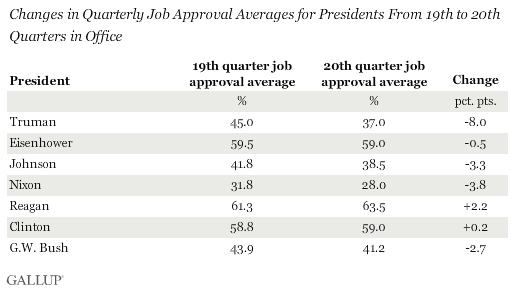PRINCETON, NJ -- President Barack Obama averaged a 44.5% job approval rating during his 19th quarter in office, a decline of more than three percentage points from his 18th quarter. That is one of the largest quarter-to-quarter declines of his presidency, behind a nine-point drop in his third quarter and a six-point drop in his 11th quarter.

The 19th quarter, which ran from July 20-Oct. 19, is now the third in a row in which Obama's job approval rating has declined. The current slump followed five consecutive quarters -- the 12th through the 16th -- of higher job approval.
Obama's Gallup daily job approval ratings tended to be higher earlier in his 19th quarter than in the latter part. In late August and early September, Obama sought congressional approval for military action in Syria, something the public did not favor. That military action was avoided when Russian officials helped broker a diplomatic solution.
Then, during the partial government shutdown that began Oct. 1 and included 11th-hour negotiations to increase the debt limit, his job approval dipped as low as 41%. His Gallup daily job approval ratings had not been lower since November 2011.

Obama's 19th Quarter Near Middle of Historical Distribution
Three post-World War II presidents -- Ronald Reagan, Dwight Eisenhower, and Bill Clinton -- had significantly higher 19th quarter averages, all near 60%, than Obama. Two presidents had lower 19th quarter averages than Obama: Richard Nixon, whose 19th quarter came during the Watergate investigations, and Lyndon Johnson, attributable mostly to the increasingly unpopular Vietnam War. Obama's 19th quarter approval average is most similar to those of Harry Truman and George W. Bush.

Like Obama, Bush saw his approval rating drop during his 19th quarter, which was marked by criticism of his administration's handling of the Hurricane Katrina rescue and recovery effort. Bush's approval rating generally continued to fall during the remainder of his presidency.
A decline in approval from the 19th to the 20th quarter has been the norm for presidents; only Reagan and Clinton did not see at least slight declines in their 20th quarter, and only Reagan's rating notably improved.

Implications
Obama is suffering through another approval slump, something he experienced during the latter part of his first year into his second year as president, and during the latter part of his third year. After a relatively strong fourth year that included several quarters of higher ratings that aided his re-election, his approval rating has now declined in each of the last three quarters.
The legislative battles over the federal budget and the Affordable Care Act, as well as the federal debt limit, took a toll on the president's popularity, with his Gallup daily approval rating falling to 41% at points during the shutdown.
Obama did sign into law the Senate-brokered deal to end the government shutdown and raise the federal debt limit before the Oct. 17 deadline without also gutting the Affordable Care Act. The effect of those events on his popular support is not yet clear, but will be evident in the coming days of Gallup Daily tracking.
Explore President Obama's approval ratings in depth and compare them with those of past presidents in the Gallup Presidential Job Approval Center.
Survey Methods
Results for this Gallup poll are based on telephone interviews conducted July 20-Oct. 19, 2013, on the Gallup Daily tracking survey, with a random sample of 47,049 adults, aged 18 and older, living in all 50 U.S. states and the District of Columbia.
For results based on the total sample of national adults, one can say with 95% confidence that the margin of sampling error is ±1 percentage point.
Interviews are conducted with respondents on landline telephones and cellular phones, with interviews conducted in Spanish for respondents who are primarily Spanish-speaking. Each sample of national adults includes a minimum quota of 50% cellphone respondents and 50% landline respondents, with additional minimum quotas by region. Landline and cell telephone numbers are selected using random-digit-dial methods. Landline respondents are chosen at random within each household on the basis of which member had the most recent birthday.
Samples are weighted to correct for unequal selection probability, nonresponse, and double coverage of landline and cell users in the two sampling frames. They are also weighted to match the national demographics of gender, age, race, Hispanic ethnicity, education, region, population density, and phone status (cellphone only/landline only/both, and cellphone mostly). Demographic weighting targets are based on the March 2012 Current Population Survey figures for the aged 18 and older U.S. population. Phone status targets are based on the July-December 2011 National Health Interview Survey. Population density targets are based on the 2010 census. All reported margins of sampling error include the computed design effects for weighting.
In addition to sampling error, question wording and practical difficulties in conducting surveys can introduce error or bias into the findings of public opinion polls.
For more details on Gallup's polling methodology, visit www.gallup.com.
